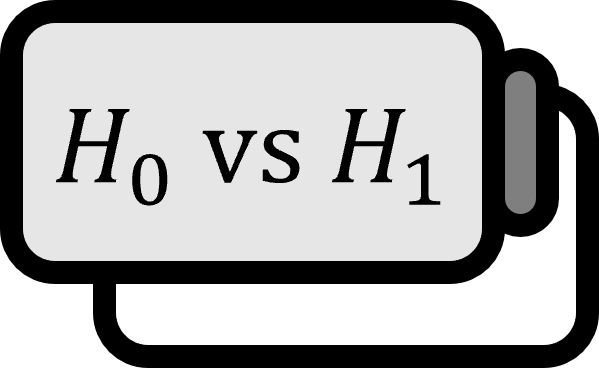How to Set the Null Hypothesis and Alternative Hypothesis
Description
Hypothesis Testing: Null Hypothesis $H_{0}$ vs Alternative Hypothesis $H_{1}$
As of April 2018, some textbooks and Wikipedia describe the null hypothesis as ’the hypothesis that is initially assumed to be rejected in statistics’, and the alternative hypothesis as ’the hypothesis that one hopes or expects to prove through research’. However, if you only study the necessary parts of statistics or lightly know about it, that might be fine, but as you delve deeper, it becomes difficult to unconditionally agree with such definitions.
Unscientific Expression: Expectation and Anticipation
In the actual context of science, there’s no need for lengthy explanations as there are many clear examples. Let’s think about a bit closer to real society just for this paragraph. For now, let’s consider the alternative hypothesis not as the hypothesis ’that one hopes or expects to prove through research’ but ’that one hopes or expects to prove through trial'.

Imagine Alice has sued Bob. In order to prove Bob’s guilt, there must be considerably conclusive evidence, following the principle of the presumption of innocence. In a trial, what matters is not whether a crime exists but rather whether the crime can be proven, and here the null hypothesis $H_{0}$ is ‘Bob is not guilty’, and $H_{1}$ becomes ‘Bob is guilty’. However, it’s strange to consider the null hypothesis in such trials as ’the hypothesis that is initially assumed to be rejected’. It wouldn’t be fair to say that Alice, who wants to prove Bob’s crime, should set the null and alternative hypotheses this way. This is because lawyers, judges, and jurors all proceed with the trial under the same null and alternative hypotheses. Would Bob’s lawyer set ‘Bob is not guilty’ as the alternative hypothesis in this trial? Certainly not.

If you’re unconvinced, imagine Bob counter-sues Alice for defamation. Normally, one of them is definitely guilty, and what Bob wants to prove here is that Alice committed defamation. Although it might seem fine to consider each trial separately, focusing back on the initial event that led Alice to sue in the first place, defining the null hypothesis based on what ’to reject’ or ’to prove’ is not appropriate.
Researcher’s Intention
Of course, this is a legal discussion. In ‘statistics’ or ‘research’, it could be different. However, there are plenty of examples in statistics and research where the null hypothesis is what one wishes to prove. In logistic regression analysis, when selecting a model, what is usually expected is that the model fits well, but indeed, in actual goodness-of-fit tests, the null hypothesis is that the model fits well. In a study to prove the non-existence of unicorns in reality, would the null hypothesis be ‘unicorns exist’? Likely not.
The point is whether it’s a trial or research, the null and alternative hypotheses are not defined based on someone’s ‘intention’. Saying ‘Bob is innocent’ or ‘Bob is not guilty’ changes nothing except for a minor difference in legal interpretation. Regression analysis can be confusing initially because of difficulties in distinguishing such ’negatives’.
When considering the difference between affirmation and negation in English and our language, it can be enlightening. For instance, if Bob dislikes playing a certain game:
- If Alice asks in our language, “Do you want to play the game?” Bob would answer, “No, I don’t want to.” Conversely, if asked, “Don’t you want to play the game?” Bob would reply, “Yes, I don’t want to.”
- Meanwhile, if Alice asks in English, “Do you wanna play this game?” Bob would say, “No, I don’t.” Similarly, if asked, “Don’t you wanna play this game?” Bob would still respond, “No, I don’t.”
Metaphorically, hypothesis testing should be like asking in English, where regardless of whether the question is affirmative or negative, a consistent answer is returned. When conducting hypothesis testing using a certain distribution, it changes based on the characteristics of that distribution, not the researcher’s intention.
See Also
- An Easy Definition of Hypothesis Testing: Introduces a definition of hypothesis testing that is easier to accept rather than being strict.
- How to Define Null and Alternative Hypotheses: Explains potential issues with their definition.
- A Complex Definition of Hypothesis Testing: Introduces a relatively rigorous mathematical statistical definition of hypothesis testing.
